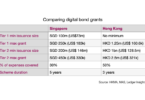Zia Zaman of MetLife’s Singapore based LumenLab has penned a whitepaper documenting the experience of implementing Metlife’s blockchain parametric insurance solution, Vitana, which we explored in depth more than a year ago.
Vitana was built to explore blockchain for insurance, with plans to use the technology for other insurance products. For this, Metlife focused on a niche market, gestational diabetes mellitus (GDM), which occurs in pregnant women and disappears after delivery. However, the condition is harmful to the baby and may lead to complications during birth.
Unlike many insurance applications where blockchain is used only for internal processes, Vitana is a consumer-centric insurance solution. The most significant pain point in the insurance sector is claims and the various back-end processes to issue a payout. By authorizing the app to link to their medical records, a smart contract on a private Ethereum-based blockchain can trigger a payment to the customer without the need to make a claim.
Cognizant was the implementation partner in the project alongside Swiss Re as the insurer, Vault Dragon for medical integration and the Monetary Authority of Singapore (MAS) to use its sandbox.
The takeaways
The whitepaper noted some of the observations with regards to the diabetes insurance project. Firstly, blockchain addressed an actual consumer need and enabled a frictionless consumer experience. Secondly, real-time access to medical data proved beneficial to all stakeholders.
The last takeaway was that getting data prepared to go onto a blockchain was more difficult than setting up the network itself. Since the data uploaded onto a blockchain is unchangeable, it makes it even more critical to ensure the accuracy of the data at the point of input.
“When we designed the process flow [for medical data] in partnership with the clinic, we needed to rewire existing processes, which was an incredible change management effort,” said Zia Zaman, Chief Innovation Officer of MetLife Asia.
What’s in store for the future?
In the whitepaper, Zaman envisions the next stages of blockchain for the industry.
Firstly, blockchain can be used for effortless processing of parametric insurance. This type of insurance provides a payout based on the occurrence of a specific event rather than a claim. For insurers, because parametric insurance doesn’t require claims, it lowers costs and increases efficiency.
Meanwhile, for customers, blockchain provides a smooth experience. The technology eliminates most intermediaries such as brokers and simplifies the sign-up process. The whitepaper observed an automated payout process backed by an objective quantitative result also reduces the risk of fraud.
Most inefficiencies are introduced owing to manual processes. With blockchain, the back-end services can be fully automated to ensure smooth functionality.
Zaman observes that blockchain provides customers with certainty regarding insurance products. It makes clear to that in the event of “this” happening, “that” is what you will get, automatically.
Going forward, Zaman expressed an interest in underrepresented insurance segments such as women, middle-class farmers, those aged 80+ and people of faith.
More recently, LumenLabs has started to explore LifeChain to initiate the life insurance claims process in Singapore.






